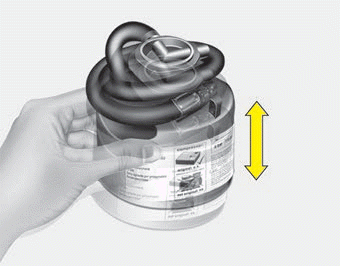Kia Rio: If you have a flat tire (with Tire Mobility Kit) / Using the Tire Mobility Kit

Carefully follow below steps.
1. Shake the sealant case.

2. Connect the filling hose (3) onto the connector of the sealant bottle (A).
3. Insert the sealant bottle into the housing of the compressor(B) so that the bottle is upright.
4. Ensure that button (9) on the compressor is not pressed.

5. Unscrew the valve cap from the valve of the defective wheel and screw filling hose (3) of the sealant bottle onto the valve.

✽ NOTICE
If the sealant is injected when the tire air pressure injection valve and sealant injection hose are not fully interlocked, the sealant may overflow and clog the valve.
✽ NOTICE
If a visable foreign object has punctured the tire, do not remove it before using Tire Mobility Kit.

6. Ensure that the compressor is switched off, position 0.
7. Connect between compressor and the vehicle power outlet (4) using the cable and connectors.
8. With the engine start/stop button position on or ignition switch position on, switch on the compressor and let it run for approximately 5~7 minutes to fill the sealant up to proper pressure. (refer to the Tire and Wheels, chapter 9). The inflation pressure of the tire after filling is unimportant and will be checked/corrected later. Be careful not to overinflate the tire and stay away from the tire when filling it.
WARNING - Tire pressure
Do not attempt to drive your vehicle if the tire pressure is below 200 kPa (29 psi). This could result in an accident due to sudden tire failure.
9. Switch off the compressor.
10. Detach the hoses from the sealant bottle connector and from the tire valve.
Return the Tire Mobility Kit to its storage location in the vehicle.
WARNING - Carbon monoxide
Carbon monoxide poisoning and suffocation is possible if the engine is left running in a poorly ventilated or unventilated location (such as inside a building).
 Components of the Tire Mobility Kit
Components of the Tire Mobility Kit
1. Speed restriction label
2. Sealant bottle and label with speed restriction
3. Filling hose from sealant bottle to wheel
4. Connectors and cable for the power outlet direct connection
5. Holde ...
 Distributing the sealant
Distributing the sealant
11. Immediately drive approximately 7~10 km or, about 10 min (4~6 miles) to evenly
distribute the sealant in the tire.
Do not exceed a speed of 80 km/h (50 mph). If possible, do not fall below a ...
Other information:
Kia Rio 2017-2025 YB Service Manual: Cooling System
Components and components location Components 1. Radiator 2. Radiator upper hose 3. Radiator lower hose 4. Filler neck assembly 5. Cooling fan assembly 6. Radiator upper mounting bracket [LH] 7. Radiator upper mounting bracket [RH] 8. Ra ...
Kia Rio 2017-2025 YB Owners Manual: Finish damage repair, Bright-metal maintenance
Finish damage repair Deep scratches or stone chips in the painted surface must be repaired promptly. Exposed metal will quickly rust and may develop into a major repair expense. If your vehicle is damaged and requires any metal repair or replacement, be sure the body shop applies anti-corrosio ...
